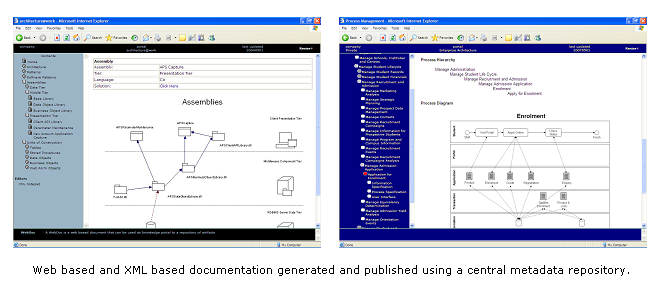KASE Tools
Are KASE Tools technology platform dependent and proprietary?
KASE is a concept that is essentially platform independent or platform-agnostic. The concepts are universal to all systems and methods. Our Source Code is open and is a learning or knowledge tool - not a product. We do not sell software - it comes with the service package because we cannot empower people with knowledge in black boxes. If knowledge is to be shared, then source code must be shared. We want to teach people to teach themselves with the view to teaching others.
Portals, Services and Tools
These are the software and application architecture automating, deploying and exchanging information. Repository based software can be used to dynamically configure "Knowledge Portals" - web enabled content and applications. Companies should build or implement the tools that empower people to interact in a knowledge sharing community - becoming "The Learning Organisation". While components of this architecture can be purchased, enterprises that have the power to build, can better respond to changes in their environment as and when they happen - becoming the "Real-Time Enterprise" .

Methodologies
Many companies acquire or develop a methodology or set of best practices for things such as software systems - from analysis and design to implementation and maintenance. Methodologies used by the company are critical because they determine the processes that enable or constrain the way the business meets it's objectives. Methodologies should balance the integrity of an architecture and delivery. Methodologies influence standards, policies and procedures.
Best Practices
We assist in the identification, adoption and implementation of appropriate best practices.
Software Development Methodology
The development of a SDM is key to enabling rapid business delivery and architectural integrity. Developing or tailoring an existing methodology is a critical success factor. This is one of our key strengths.
Policies and Procedures
Developing a set of policies and procedures is important for establishing clear processes, but they should also be living and dynamic, i.e. support business process changes and improvements.
Standards
Quality is measured by standards, so automate its use. A well developed set of standards motivates individuals, integrates, and is natural to apply.

Architectural Blueprints
Documents, Definitions, Diagrams, Models and Artefacts; all abstract concepts and representations of what your company is and how it is designed to interact with it's business environment, people and things, both inside and outside of the organisational boundaries. "Blueprints" represent the structure of your enterprise, the codified knowledge within it's communities and how your processes, systems and software integrate.
Meta-Models
Architectural Meta-Models help define your architecture and provide a guideline for people. The value of this cannot be under-estimated. It provides clarity of understanding and is a collection of the best practices you adopt.
Blueprint Templates
Blueprints represent all the models of your organisation - business process models, data models, object models, etc. Templates are guides and aids for using these models - diagrams and notations.

Repositories
Dynamic store for artefacts, objects and models i.e. Process Models, Object Models, Data Models, etc., which are used for automation and configuration. Where do you store your "blueprints"? Is it readily available or does it have to be intepreted from your business data? Databases store your business data. But what about the meta-data - the data about the data? A repository or meta-data store (database and/or file system) is essential for facilitating the "Learning Organisation" and "Real-Time Enterprise".
CASE Tools and Code Generators
We provide foundation CASE Tools where the source code and configuration can be adopted to suit your requirements. Forward and reverse engineer meta-data in the repository.

Prototyping Templates
Prototyping assists in rapid development and is one of the most powerful tools, when used properly, for acquiring user input and meeting the functional user requirements.
Source Code Libraries
Use re-usable libraries and take ownership of the source code - no hidden black boxes.